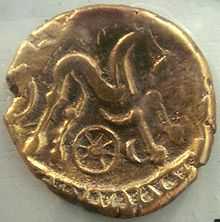Suessiones


The Suessiones were a Belgic tribe of Western Belgium in the 1st century BC, inhabiting the region between the Oise and the Marne, based around the present-day city of Soissons. They were conquered in 57 BC by Julius Caesar.
They may have also been known to the Romans as Suaeuconi.[1]
Caesar recounts in his Gallic Wars that in 57 BC the Suessiones were ruled by Galba, and that in living memory of that time their king Diviciacus had exercised sovereignty over most of the Belgians and even parts of Britain.[2]
Coinage minted by Belgic Gauls first appeared in Britain in the mid-2nd century bc with the coinage now categorized as the "Gallo-Belgic A" type.[3] Coins associated with King Diviciacus of the Suessiones, issued near or between 90 and 60 bc, have been categorized as "Gallo-Belgic C." Finds of this issue of coin extend from Sussex to the Wash, with a concentration of finds near Kent. A later issue of coin, "Gallo-Belgic F" (c. 60-50 bc), has concentrated finds near Paris, throughout the lands of the Suessiones, and the southern, coastal areas of Britain. These finds lead scholars to suggest that the Suessiones had significant trade and migration into Britain during the 2nd and 1st centuries prior to Roman conquest.[4]
Caesar describes the Belgae as going to Britain looking for booty: "The inland part of Britain is inhabited by tribes declared in their own tradition to be indigenous to the island, the maritime part by tribes that migrated at an earlier time from Belgium to seek booty by invasion. ..."[5]
The town mentioned by Caesar as their capital, Noviodunum ("New hill-fort"), established the present city of Soissons. The city of Soissons has remained the regional capital of the contemporary provence of Aisne, north of the region of Champagne. It was the capital city of the Merovingian Kingdom of Soissons, 511-613. Soissons was the birthplace of the Frankish Prince Charlemagne, in the year 747, son of King Pippin the Short and Bertrada of Laon.
The region is still commonly referred to as the "Soissonnais" and people of the region are the "Soissonaire."
See also
- List of peoples of Gaul
- List of Celtic tribes
References
- ↑ Pliny the Elder, "4:31,footnote 19", in John Bostock; Henry Thomas Riley, Historia Naturalis
- ↑ Commentarii de Bello Gallico, Gaius Julius Caesar, 57 bc, p. ii
- ↑ http://www.britishmuseum.org/explore/highlights/highlight_objects/cm/g/gold_stater_gallo-belgic_a_ty.aspx
- ↑ http://www.roman-britain.org/tribes/belgae.htm
- ↑ Commentarii de Bello Gallico, Gaius Julius Caesar, 57 bc, v.12
| ||||||||||||||||||||
| ||||||||||||||||||||||||||||||||||||

